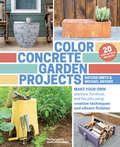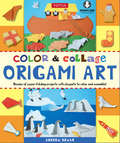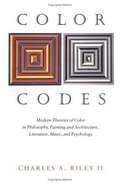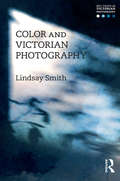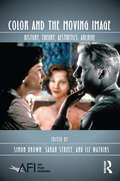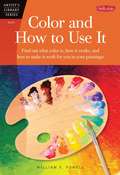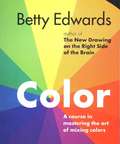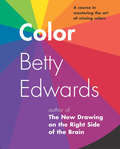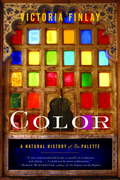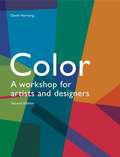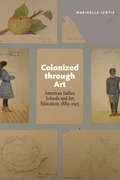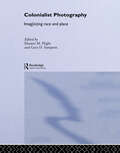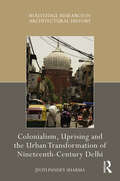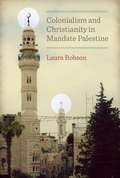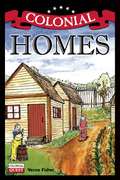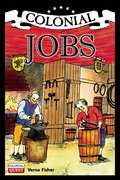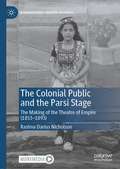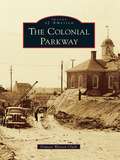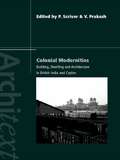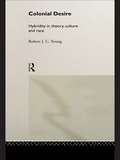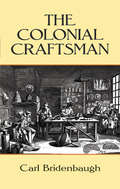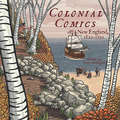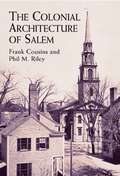- Table View
- List View
Color Concrete Garden Projects: Make Your Own Planters, Furniture, and Fire Pits Using Creative Techniques and Vibrant Finishes
by Michael Snyder Nathan Smith Charles ColemanA Library Journal Best Crafts & DIY Book of 2015 Incorporating concrete design into a home garden can now be easily achieved by any do-it-yourself enthusiast! Concrete furniture and containers add style and personality to outdoor spaces, and the addition of color makes these objects even more eye-catching. These trendy pieces can cost thousands of dollars at garden centers and furniture stores, but they can also be made affordably at home. In this hands-on guide, concrete artisans Nathan Smith and Michael Snyder offer basic information on how to mix concrete and add color using dyes, paints, and inlaid materials. The twenty step-by-step projects include small items, like a candle holder with an old-world feel and a simple stacked-ring planter, and larger pieces, like an elegant bike rack and a beautiful fire pit that is the perfect gathering place for friends and family.
Color & Collage Origami Art
by Andrew DewarMake lively scenes out of paper models with this fun children's origami ebook.Kids love to make crafts. Whether it's scribbling on a page, putting stickers all over everything or cutting out crazy shapes, kids take supreme pleasure in being crafty.The Color & Collage Origami Art is a unique new origami paper craft product that will teach children to fold, assemble, compose, color and display large collages. They'll have fun folding individual origami models for stand-alone play and as an added bonus being able to arrange these pieces on the included collage backgrounds. All of the folds are designed to be origami-for-kids projects and are a great way to learn origami. None of the projects require paint or tools so just grab some origami paper and start folding right away!The ebook contains: Step-by-step instruction Easy-to-follow diagrams 35 fun origami projectsRegardless of skill level, kids will be folding like a pro right out of the gate with The Color & Collage Origami ebook.Origami Projects include: Gingerbread House Starry Sky Playhouse Penguin Picnic Christmas TreeNoah's Ark
Color Codes: Modern Theories of Color in Philosophy, Painting and Architecture, Literature, Music and Psychology
by Charles A. Riley IIScholarly Essays on the symbolic use of color in the arts and literature.
Color and Victorian Photography (Key Texts in Victorian Photography)
by Lindsay SmithNineteenth-century photography is usually thought of in terms of ‘black and white’ images, but intense experimentation with generating and fixing colors pre-dated the public announcement of the daguerreotype in 1839. Introducing readers to the long, frequently overlooked story of the relationship of color to photography, this short anthology of primary sources includes: accounts of the scientific search for color by Elizabeth Fulhame and Sir John Herschel;photographers' views on color; extracts from the photographic press and from manuals on handcoloring; and accounts by critics such as John Ruskin. The volume provides a fresh perspective on the culture, history and theory of early photography, demonstrating why scientists, philosophers, photographers, literary writers and artists were so fascinated by the potential for polychrome in photographs. With an introductory essay arguing that from the earliest days of photography the prospect of color loomed large in the imagination of its creators, users and critics, this reader is an essential resource for students and scholars wanting to gain a full understanding of nineteenth-century photography and its relationship to art history, literature and culture.
Color and the Moving Image: History, Theory, Aesthetics, Archive (AFI Film Readers)
by Simon Brown Sarah Street Liz WatkinsThis new AFI Film Reader is the first comprehensive collection of original essays on the use of color in film. Contributors from diverse film studies backgrounds consider the importance of color throughout the history of the medium, assessing not only the theoretical implications of color on the screen, but also the ways in which developments in cinematographic technologies transformed the aesthetics of color and the nature of film archiving and restoration. Color and the Moving Image includes new writing on key directors whose work is already associated with color—such as Hitchcock, Jarman and Sirk—as well as others whose use of color has not yet been explored in such detail—including Eric Rohmer and the Coen Brothers. This volume is an excellent resource for a variety of film studies courses and the global film archiving community at large.
Color and How to Use It
by William F. PowellFrom the most delicate pastel tint to the boldest bright hue, color is a vitally important tool to you as an artist. Whether your preferred medium is acrylic, oil, or watercolor, a strong understanding of color and its applications is essential. Color and How to Use It includes in-depth information on color theory, important properties of color and light, and the fundamentals of color mixing. This comprehensive guide will teach you what color is, how it works, and how to make it work for you in your paintings.
Color: A Course in Mastering the Art of Mixing Colors
by Betty EdwardsMillions of people have learned to draw using the methods of Dr. Betty Edwards's bestseller The New Drawing on the Right Side of the Brain. Now, much as artists progress from drawing to painting, Edwards moves from black-and-white into color. This much-awaited new guide distills the enormous existing knowledge about color theory into a practical method of working with color to produce harmonious combinations. Using techniques tested and honed in her five-day intensive color workshops, Edwards provides a basic understanding of how to see color, how to use it, and-for those involved in art, painting, or design-how to mix and combine hues. Including more than 125 color images and exercises that move from simple to challenging, this volume explains how to: see what is really there rather than what you "know" in your mind about colored objects perceive how light affects color, and how colors affect one another manipulate hue, value, and intensity of color and transform colors into their opposites balance color in still-life, landscape, figure, and portrait painting understand the psychology of color harmonize color in your surroundings While we recognize and treasure the beautiful use of color, reproducing what we see can be a challenge. Accessibly unweaving color's complexity, this must-have primer is destined to be an instant classic.
Color: A Course in Mastering the Art of Mixing Colors
by Betty EdwardsMillions of people have learned to draw using the methods of Dr. Betty Edwards's bestseller The New Drawing on the Right Side of the Brain. Now, much as artists progress from drawing to painting, Edwards moves from black-and-white into color. This much-awaited new guide distills the enormous existing knowledge about color theory into a practical method of working with color to produce harmonious combinations.Using techniques tested and honed in her five-day intensive color workshops, Edwards provides a basic understanding of how to see color, how to use it, and-for those involved in art, painting, or design-how to mix and combine hues. Including more than 125 color images and exercises that move from simple to challenging, this volume explains how to:see what is really there rather than what you "know" in your mind about colored objectsperceive how light affects color, and how colors affect one anothermanipulate hue, value, and intensity of color and transform colors into their oppositesbalance color in still-life, landscape, figure, and portrait paintingunderstand the psychology of colorharmonize color in your surroundingsWhile we recognize and treasure the beautiful use of color, reproducing what we see can be a challenge. Accessibly unweaving color's complexity, this must-have primer is destined to be an instant classic.
Color
by Victoria FinlayIn this vivid and captivating journey through the colors of an artist's palette, Victoria Finlay takes us on an enthralling adventure around the world and through the ages, illuminating how the colors we choose to value have determined the history of culture itself.How did the most precious color blue travel all the way from remote lapis mines in Afghanistan to Michelangelo's brush? What is the connection between brown paint and ancient Egyptian mummies? Why did Robin Hood wear Lincoln green? In Color, Finlay explores the physical materials that color our world, such as precious minerals and insect blood, as well as the social and political meanings that color has carried through time.Roman emperors used to wear togas dyed with a purple color that was made from an odorous Lebanese shellfish-which probably meant their scent preceded them. In the eighteenth century, black dye was called logwood and grew along the Spanish Main. Some of the first indigo plantations were started in America, amazingly enough, by a seventeen-year-old girl named Eliza. And the popular van Gogh painting White Roses at Washington's National Gallery had to be renamed after a researcher discovered that the flowers were originally done in a pink paint that had faded nearly a century ago. Color is full of extraordinary people, events, and anecdotes-painted all the more dazzling by Finlay's engaging style.Embark upon a thrilling adventure with this intrepid journalist as she travels on a donkey along ancient silk trade routes; with the Phoenicians sailing the Mediterranean in search of a special purple shell that garners wealth, sustenance, and prestige; with modern Chilean farmers breeding and bleeding insects for their viscous red blood. The colors that craft our world have never looked so bright.From the Hardcover edition.
Color: A Natural History of the Palette
by Victoria FinlayIn this vivid and captivating journey through the colors of an artist's palette, Victoria Finlay takes us on an enthralling adventure around the world and through the ages, illuminating how the colors we choose to value have determined the history of culture itself.How did the most precious color blue travel all the way from remote lapis mines in Afghanistan to Michelangelo's brush? What is the connection between brown paint and ancient Egyptian mummies? Why did Robin Hood wear Lincoln green? In Color, Finlay explores the physical materials that color our world, such as precious minerals and insect blood, as well as the social and political meanings that color has carried through time.Roman emperors used to wear togas dyed with a purple color that was made from an odorous Lebanese shellfish-which probably meant their scent preceded them. In the eighteenth century, black dye was called logwood and grew along the Spanish Main. Some of the first indigo plantations were started in America, amazingly enough, by a seventeen-year-old girl named Eliza. And the popular van Gogh painting White Roses at Washington's National Gallery had to be renamed after a researcher discovered that the flowers were originally done in a pink paint that had faded nearly a century ago. Color is full of extraordinary people, events, and anecdotes-painted all the more dazzling by Finlay's engaging style.Embark upon a thrilling adventure with this intrepid journalist as she travels on a donkey along ancient silk trade routes; with the Phoenicians sailing the Mediterranean in search of a special purple shell that garners wealth, sustenance, and prestige; with modern Chilean farmers breeding and bleeding insects for their viscous red blood. The colors that craft our world have never looked so bright.From the Hardcover edition.
Color: Travels Through the Paintbox
by Victoria FinlayPart travelogue, part narrative history, 'Colour' unlocks the history of the colours of the rainbow, and reveals how paints came to be invented, discovered, traded and used. This remarkable and beautifully written book remembers a time when red paint was really the colour of blood, when orange was the poison pigment, blue as expensive as gold, and yellow made from the urine of cows force-fed with mangoes. It looks at how green was carried by yaks along the silk road, and how an entire nation was founded on the colour purple. Exciting, richly informative, and always surprising, 'Colour' lifts the lid on the historical palette and unearths an astonishing wealth of stories about the quest for colours, and our efforts to understand them.
Color: A Workshop for Artists and Designers
by David HornungTaking a practical approach to color,Color: A workshop for artists and designers is an invaluable resource for art students and professionals alike. With its sequence of specially designed assignments and in-depth discussions, it effectively bridges the gap between color theory and practice to inspire confidence and understanding in anyone who works with color. Generously illustrated--including all-new, contemporary examples--this book provides a unique set of tools that make the complex theory of color accessible and practical.
Colonized through Art: American Indian Schools and Art Education, 1889-1915
by Marinella LentisColonized through Art explores how the federal government used art education for American Indian children as an instrument for the “colonization of consciousness,” hoping to instill the values and ideals of Western society while simultaneously maintaining a political, social, economic, and racial hierarchy. Focusing on the Albuquerque Indian School in New Mexico, the Sherman Institute in Riverside, California, and the world’s fairs and local community exhibitions, Marinella Lentis examines how the U.S. government’s solution to the “Indian problem” at the end of the nineteenth century emphasized education and assimilation. Educational theories at the time viewed art as the foundation of morality and as a way to promote virtues and personal improvement. These theories made the subject of art a natural tool for policy makers and educators to use in achieving their assimilationist goals of turning student “savages” into civilized men and women. Despite such educational regimes for students, however, indigenous ideas about art oftentimes emerged “from below,” particularly from well-known art teachers such as Arizona Swayney and Angel DeCora.Colonized through Art explores how American Indian schools taught children to abandon their cultural heritage and produce artificially “native” crafts that were exhibited at local and international fairs. The purchase of these crafts by the general public turned students’ work into commodities and schools into factories.
Colonialist Photography: Imag(in)ing Race and Place
by Eleanor M. Hight Gary D. SampsonColonialist Photography is an absorbing collection of essays and photographs exploring the relationship between photography and European and American colonialism. The book is packed with well over a hundred captivating images, ranging from the first experiments with photography as a documentary medium up to the decolonization of many regions after World War II. Reinforcing a broad range of Western assumptions and prejudices, Eleanor M. Hight and Gary D. Sampson argue that such images often assisted in the construction of a colonial culture.
Colonialism, Uprising and the Urban Transformation of Nineteenth-Century Delhi (Routledge Research in Architectural History)
by Jyoti Pandey SharmaNo other city in the Indian subcontinent can lay claim to having so many lives as Delhi. This book examines Delhi in the politically and culturally dynamic nineteenth century which was marked midway by the 1857 uprising against British colonial rule as a watershed event. Following British occupation, Delhi became a receptacle for encounters between the centuries-old Mughal traditions and the incoming colonial ideal, producing a traditionalism-modernity binary. Employing the built environment lens, the book traces the architectural trajectory of Delhi as it transitioned from the seventeenth-century Mughal Badshahi Shahar (imperial city) first into a culturally hybrid Dilli-Delhi combine of the pre-uprising era and thereafter into a modern British city following the uprising. This transition is presented via four constructs that draw on the traditionalism-modernity binary of Mughal and British Delhi and include Marhoom Dilli (Dead Delhi); Picturesque Delhi; Baaghi Dilli (Insurgent Delhi) and Tamed Delhi. The book goes beyond the nineteenth century to examine the vestiges of Delhi’s four nineteenth-century lives in the present while making a case for their acknowledgement as a cultural asset that can propel the city’s urban development agenda. By bringing together the city’s past and its present as well as addressing its future, the book can count among its readers not just scholars but also those interested in cities and their evolving landscapes.
Colonialism and Christianity in Mandate Palestine
by Laura RobsonDrawing on a rich base of British archival materials, Arabic periodicals, and secondary sources, Colonialism and Christianity in Mandate Palestine brings to light the ways in which the British colonial state in Palestine exacerbated sectarianism. By transforming Muslim, Christian, and Jewish religious identities into legal categories, Laura Robson argues, the British ultimately marginalized Christian communities in Palestine. Robson explores the turning points that developed as a result of such policies, many of which led to permanent changes in the region's political landscapes. Cases include the British refusal to support Arab Christian leadership within Greek-controlled Orthodox churches, attempts to avert involvement from French or Vatican-related groups by sidelining Latin and Eastern Rite Catholics, and interfering with Arab Christians' efforts to cooperate with Muslims in objecting to Zionist expansion. Challenging the widespread but mistaken notion that violent sectarianism was endemic to Palestine, Colonialism and Christianity in Mandate Palestine shows that it was intentionally stoked in the wake of British rule beginning in 1917, with catastrophic effects well into the twenty-first century.
Colonial Quest: Colonial Homes
by Verna FisherTaking young readers on a journey back in time, this dynamic new series showcases various aspects of colonial life, from people and clothing to homes and food. Each book contains creative illustrations, interesting facts, highlighted vocabulary words, end-of-book challenges, and sidebars that help children understand the differences between modern and colonial life and inspire them to imagine what it would have been like to grow up in colonial America. The volumes in this series focus on the colonists but also include relevant information about Native Americans, offering a variety of perspectives on life in the colonies.
Colonial Quest: Colonial Jobs
by Verna FisherTaking young readers on a journey back in time, this dynamic new series showcases various aspects of colonial life, from people and clothing to homes and food. Each book contains creative illustrations, interesting facts, highlighted vocabulary words, end-of-book challenges, and sidebars that help children understand the differences between modern and colonial life and inspire them to imagine what it would have been like to grow up in colonial America. The volumes in this series focus on the colonists but also include relevant information about Native Americans, offering a variety of perspectives on life in the colonies. Discussing the various products made by colonists--from flour and iron horseshoes to wooden buckets and furniture--this engaging guidebook teaches young readers about the different craftsmen of the era, including blacksmiths, coppers, and millers. Additional attention is also paid to the goods produced by Native Americans, including leather moccasins and woven baskets, and how these goods were exchanged in a barter economy.
The Colonial Public and the Parsi Stage: The Making of the Theatre of Empire (1853-1893) (Transnational Theatre Histories)
by Rashna Darius NicholsonThe Colonial Public and the Parsi Stage is the first comprehensive study of the Parsi theatre, colonial South and Southeast Asia’s most influential cultural phenomenon and the precursor of the Indian cinema industry. By providing extensive, unpublished information on its first actors, audiences, production methods, and plays, this book traces how the theatre—which was one of the first in the Indian subcontinent to adopt European stagecraft—transformed into a pan-Asian entertainment industry in the second half of the nineteenth century. Nicholson sheds light on the motivations that led to the development of the popular, commercial theatre movement in Asia through three areas of investigation: the vernacular public sphere, the emergence of competing visions of nationhood, and the narratological function that women served within a continually shifting socio-political order. The book will be of interest to scholars across several disciplines, including cultural history, gender studies, Victorian studies, the sociology of religion, colonialism, and theatre.
Colonial Parkway, The (Images of America)
by Frances Watson ClarkThe Colonial Parkway is a living timeline to the critical beginnings of our nation. Connecting a historic triangle of cities, the parkway winds along the James River overlooking Jamestown Island, where the first permanent English colony was established; through Williamsburg, the Colonial seat of government for the new country; and arrives in Yorktown, where the fledgling nation won independence from the British at the end of the Revolutionary War. The vision of the early directors of the U.S. National Park Service became the foundation for getting the approval to construct a road that would allow visitors to move from one historic place to the next without the disruptions of the modern world. Construction began in the early 1930s, and the final phase was finished in 1957 for the 350th anniversary of the founding of Jamestown. While the parkway is a marvel in engineering, the area it covers also serves as a recreational locale for biking, fishing, and hiking.
Colonial Modernities: Building, Dwelling and Architecture in British India and Ceylon (Architext)
by Peter Scriver Vikramaditya PrakashA carefully crafted selection of essays from international experts, this book explores the effect of colonial architecture and space on the societies involved – both the colonizer and the colonized. Focusing on British India and Ceylon, the essays explore the discursive tensions between the various different scales and dimensions of such 'empire-building' practices and constructions. Providing a thorough exploration of these tensions, Colonial Modernities challenges the traditional literature on the architecture and infrastructure of the former European empires, not least that of the British Indian 'Raj'. Illustrated with seventy-five halftone images, it is a fascinating and thoroughly grounded exposition of the societal impact of colonial architecture and engineering.
Colonial Desire: Hybridity in Theory, Culture and Race
by Robert J. YoungThe language of contemporary cultural theory shows remarkable similarities with the patterns of thought which characterised Victorian racial theory. Far from being marked by a separation from the racialised thinking of the past, Colonial Desire shows we are operating in complicity with historical ways of viewing 'the other', both sexually and racially.Colonial Desire is a controversial and bracing study of the history of Englishness and 'culture'. Robert Young argues that the theories advanced today about post-colonialism and ethnicity are disturbingly close to the colonial discourse of the nineteenth century. 'Englishness', Young argues, has been less fixed and stable than uncertain, fissured with difference and a desire for otherness.
The Colonial Craftsman
by Carl BridenbaughIn colonial America, craftsmen comprised the largest segment of the population, after farmers. They were cabinetmakers, silversmiths, pewterers, printers, painters, engravers, blacksmiths, brass button-makers, shipwrights, hatters, shoemakers, and other artisans, and they manufactured the tools, clothing, household goods, and other essential products needed to sustain life and trade in the New World. <p><p> In this superb study, a distinguished American historian examines the lives and work of American craftsmen in the years before the Revolution — the golden age of colonial craftsmanship — showing them at work, at play, at worship, at school, at home, competing in their trades, striving to get ahead, and playing a dynamic role as citizens in bringing about American independence.Natural resources, special crafts of the different colonies, and New World "marketing" of those crafts are closely studied. Students of American history, culture, and the arts and crafts will find this a richly rewarding study — authoritative, well-researched, and highly readable. It is further enhanced with carefully chosen illustrations from Diderot's Encyclopédie, the great 18th-century reference work on technology, whose detailed engravings accurately represent the crafts of the period.
Colonial Comics: New England: 1620 - 1750 (Colonial Comics)
by Jason RodriguezColonial Comics is a graphic novel collection of twenty stories focusing on the colonial period from 1620 through 1750 in New England. <P><P> Created in partnership with the Massachusetts Historical Society and the Concord Museum, these illustrated stories focus on tales you cannot find in history books. Includes stories about free thinkers, Pequots, Jewish settlers, female business owners and dedicated school teachers, whales and livestock, slavery and frontiers, and many other aspects of colonial life.Jason Rodriguez is a writer and editor whose books have been nominated for an Eisner Award and eight Harvey Awards. Jason lives in Arlington, Virginia, with his wife and their two dogs, four cats, and a parrot. You can usually find him on a street corner, staring out into the future. <P><P> <i>Advisory: Bookshare has learned that this book offers only partial accessibility. We have kept it in the collection because it is useful for some of our members. Benetech is actively working on projects to improve accessibility issues such as these.</i>
The Colonial Architecture of Salem (Dover Architecture Ser.)
by Frank Cousins Phil M. RileySalem, Massachusetts, has long been considered the center of New England's Colonial architecture, a storehouse of well-preserved American antiquities. This profusely illustrated study, first published in 1919, represents the first complete, chronological survey of Colonial architecture in Salem — from the town's settlement in 1626 to the end of its Colonial development in 1818.Focusing on such major styles as the gable and peaked-roof house, the lean-to house, the gambrel-roof house, and the square three-story house, this volume features detailed descriptions of over 100 buildings: the famous House of Seven Gables, the Governor Bradstreet Mansion, the Witch House, Nathaniel Hawthorne's Birthplace, Assembly Hall, the Old Courthouse, the Old South Church, the Salem Custom House, and numerous others. The text is enhanced by more than 250 rare illustrations of the building under discussion, as well as details of doorways and mantels, moldings, wainscoting, windows, stairways, and other features.Brimming with informative and well-illustrated descriptions of classic early New England architecture, this highly readable volume is an invaluable and inspirational sourcebook for architects and home builders. In addition, its colorful anecdotes concerning colonial Salem and its residents offer fascinating fare for historians and other readers.
